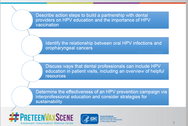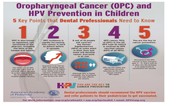 #PreteenVaxScene Webinar Recording: An Interprofessional Approach to HPV and Oropharyngeal Cancer Prevention Education
Approximately 31,500 cancers are attributed to HPV yearly and that number continues to rise. Oropharyngeal cancer has surpassed cervical cancer as the most common cancer caused by HPV. The Massachusetts Oral HPV Prevention Taskforce recently participated in a #PreteenVaxScene webinar to educate and empower dental professionals to help their patients make informed decisions about oral health and cancer prevention. You can find this webinar as well as the rest of the #PreteenVaxScene webinar series at:
www.cdc.gov/hpv/preteenvaxscene-webinar.html
|
New CME: HPV Vaccination at 11 and 12 as a Standard of Care
Although HPV vaccination rates are rising, there are still too many unvaccinated boys and girls left vulnerable to devastating HPV cancers later in life. Vaccination could prevent most of these cancers. Healthcare professionals are parents most trusted source of health information for their children, and CDC has tips to help them make effective HPV vaccine recommendations at 11 and 12 years old. In this CME, you’ll learn how clinicians can and have been successful making HPV vaccine recommendations. In addition, they discuss how they effectively answer parents’ questions and communicate HPV vaccination information to parents and patients.
 AAP 5 Key Points Fact Sheets and Guide to Adolescent Immunizations Flip Chart
The American Academy of Pediatrics (AAP) has three new HPV Fact Sheets for dental and medical professionals, which can be found in the Printable Resources section of the HPV Champion Toolkit. These sheets can be shared electronically and/or posted to organization's websites for further distribution.
|
 |
|
The AAP has also developed a flip chart for pediatric offices and parents.This resource is aimed at helping pediatric healthcare providers discuss adolescent immunizations with their patients and families. It provides information and answers to parents' questions on adolescent vaccines in easy-to-understand infographics on one side and talking points for health care providers on the other. The flip chart is now available as an electronic resource.
|

ACS Clinical and System Action Guides
The American Cancer Society (ACS) developed Clinician and System Action Guides, which are a suite of six booklets tailored to
specific professional audiences. The guides communicate the collective guidance
of the HPV Roundtable for healthcare providers, decision makers, and support
staff to implement key interventions and strategies to raise HPV vaccination
rates.
Guide titles include:
• Physician/Physician
Assistant/Nurse Practitioner Guide
• Nurse
& Medical Assistant Guide
• Dental
Health Professionals Guide
• Large
Health Systems Guide
• Office
Team Guide
• Small
Private Practice Guide
|

HPV Vaccine:Same Way, Same Day
HPV Vaccine: Same Way, Same Day™ is a brief, interactive role-play simulation designed to enhance healthcare providers’ ability to introduce the HPV vaccine and address parents’ concerns. It is ideal immunization education for clinicians involved in residency training, quality improvement collaboratives, office in-service training, etc. The simulation was developed by the Academic Pediatric Association, the American Academy of Pediatrics, and Kognito
.
The complimentary versions are available for mobile devices:
 |
|
Facebook Group: HPV Cancer Free Family
The National HPV Vaccination Roundtable invites you to join the HPV Cancer Free Family on Facebook. This Facebook group is a place for families to find accurate information about HPV vaccination, HPV-related cancers and get answers from doctors, nurses, researchers, HPV cancer survivors and other advocates. A representative of the National HPV Vaccination Roundtable will be on-hand to answer questions and respond to comments at least once a day Monday-Friday.
|
The March issue of Academic Pediatrics offers a CDC-sponsored supplement, “Raising Human Papillomavirus Vaccination Rate.” The supplement reviews 10 years of HPV vaccination experience and offers 7 commentaries and 11 articles, with topics ranging from parent and provider perspectives to information about the integration of HPV vaccine into health systems.
While there have been advances and successes in the HPV vaccination program in the U.S., the uptake of HPV vaccine remains lower than expected. The supplement articles explore the challenges faced with this vaccine and approaches being used to address them. Topics include:
- Influence of provider communication techniques on parental attitudes toward HPV vaccine
- Evaluations on breadth of HPV counseling materials
- Quality improvement methods for improving HPV vaccination rates in clinical practice
- Discussions on the continued challenges of improving HPV vaccination coverage
- Comparative analysis of recommended HPV vaccine interventions
- Opportunities for creating vaccination coverage initiatives that extend beyond the healthcare setting
 |
|
A key factor influencing adolescent HPV vaccination is whether and how a healthcare professional recommends it. A recent article in the March issue of JAMA Pediatrics titled "Effect of a Healthcare Professional Communication Training Intervention on Adolescent Human Papillomavirus Vaccination: A Cluster Randomized Clinical Trial," has found that communication intervention has a positive impact on HPV vaccine series initiation. Numerous studies demonstrate that medical professionals often fail to communicate effectively about the HPV vaccine with patients and parents. The President’s Cancer Panel has indicated that interventions to improve healthcare professionals’ communication about adolescent HPV vaccination are needed.
|
| 
